The entire horizon lit up with the brightest light I have ever seen. Just as my eyes focused on what was going on in front of me, it all disappeared.
The scale of what I saw is beyond explanation. And the fact that no one was with me is why I’ve never shared this story before…
This was in 2004, when I was 18 years old. Just like any teenager, I thought I knew everything. But this experience shook me to my core… What had I seen?
In my mind, there were really only two explanations for this massive blast of blue-white light that lit up the sky over the Pacific Ocean:
- This was a military operation.
- This was some kind of extra terrestrial thing… you know… aliens.
When I saw that bright explosion of light over the water, my mind had nothing to reference. The intensity and size of the light I saw was so big and bright, it’s hard to explain.
I witnessed this while I was driving on Encinal Canyon, in Malibu, California, around midnight during the end of August. I was driving home, after a late night water polo game, and I had my car windows open with music playing.

This is a Google Street View screenshot of the exact location of where I saw this flash of light. For clarity, this road is elevated above the ocean, so the horizon you see here is very far away. The top red arc is how the sky lit up, and the bottom arc is where the ocean reflected the light. This area of where the sky lit up is at least 5 miles across.
There was no sound that accompanied the bright flash that lasted no more than three seconds. The ocean, below the flash of light, lit up like daylight. What in the world was it?
I’ll be honest… I was terrified. I had no idea what had happened.
There was nothing I could think of that would explain what I had just witnessed… and that’s why I never told anyone about it. No one would believe me.
Although I was temped to think that I had just seen some kind of alien ship, I also knew about the area where this flash of light occurred. It was very likely some kind of military operation… at least that’s what I kept telling myself.
To the north west of Malibu there are two military bases:
- Naval Base Ventura County: This base also owns and operates San Nicolas Island, which I’ll mention in a little bit. During the 1950’s and 1960’s this military base was responsible for most of the Navy’s development and testing of missiles.
- Vandenberg Space Force Base: Vandenberg used to be an Air Force base, but was officially renamed in May of 2021. Historically, Vandenberg has been extremely active with both public/military (NASA) and private (SpaceX) rocket launches.
Both of these bases are active and known to have had many strange activities that are often visible by the surrounding public. Usually, there is an announcement just before or just after a launch, but obviously there are lots of operations that are never reported.
Growing up in this area, and being very aware of these military bases, I wanted to believe that what I saw was related to these bases. But, on the other hand, what I had seen was way out in the ocean… and the size of the light burst was so big I couldn’t even imagine what human-made ‘thing’ could make that happen. (Maybe a nuclear bomb, but it definitely was not that.)
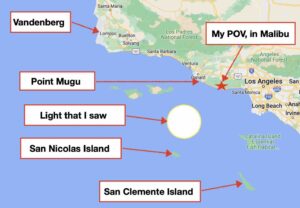
I was also aware of San Nicolas Island and San Clemente Island, which are both active military islands. San Clemente Island is especially active with a large airport, Navy SEAL training facility (with a small city built to simulate urban warfare situations), an anti-submarine warfare range. The island is also the only remaining ship-to-shore live firing range.
Considering all of this, it is most likely that I saw some sort of military operation that night. That said, I still believe what I saw was not near any of the islands and was in open water. I have no way to prove this and it’s possible that there is a logical explanation… that I will never know about.
Then, several years later, something strange happened…
On November 8th, 2010, a ‘mystery missile’ was actually filmed by a Los Angeles news helicopter.

This is a screenshot from a newscast by Fox News. However, the original footage was taken by a KCBS news helicopter over the skies of Los Angeles. The original video is difficult to find, but you can watch this version via the Wall Street Journal, here. The video caption reads: “A video that appears to show a missile launch off the coast of California is so far “unexplained” by anyone in the military, Pentagon officials say, but insist that there was “no threat to the homeland”. “
You can watch the video yourself to make your own assumptions, but over ten years later there is still not a single definitive answer to what this was. The FAA, Vandenberg, Point Mugu, the Navy, the Air Force, and even the Pentagon released statements which denied any responsibility.
Even though no government or private entities claimed responsibility, US Northern Command did say “that there is no threat to our nation, and from all indications this was not a launch by a foreign military.”
That’s an interesting statement to be released considering that two years prior, in 2007, a Chinese submarine unexpectedly popped up right in the middle of a US Navy exercise.
“The Americans had no idea China’s fast-growing submarine fleet had reached such a level of sophistication, or that it posed such a threat.
One Nato figure said the effect was “as big a shock as the Russians launching Sputnik” – a reference to the Soviet Union’s first orbiting satellite in 1957 which marked the start of the space age.” –DailyMail, 2007
Could the 2010 ‘mystery missile’ off the coast of Los Angeles been a warning shot from a Chinese submarine?
This may sound like I’m stringing together a variety of somewhat correlated events. But there is a lot more to this story… A LOT more…
It’s important to know more about the submarine that popped up in the middle of the Navy drill in 2007. It wasn’t near the United States, but in the ocean between Southern Japan and Taiwan, off the coast of China.
China was certainly flexing its muscles to the US, in a show of their new capabilities at sea. (In hindsight, this is especially obvious now that the world is watching the tense situation between China and the US, as the sovereignty of Taiwan is being questioned.)
Earlier that same year, in 2007, China also successfully demonstrated that they could shoot down a satellite that was in orbit (which was one of their own aging weather satellites).

The US, not to be outdone, shot down one of its own spy satellites the following year in February of 2008.
According to Reuters, “The Bush administration has insisted it was not trying to demonstrate anti-satellite capabilities of the Lockheed Martin Corp “Aegis” ballistic missile defense — though experts said the effect was just that. The administration said its goal was to protect populated areas from the spacecraft’s unused supply of deadly hydrazine propellant — an explanation many called unpersuasive.”
The satellite was shot down using a “Standard Missile-3” fired from the USS Lake Erie, which was located near Hawaii.
This specific missile design was never intended to shoot down satellites, but had been heavily modified to complete the task.
Whether or not this operation was in direct response to China is unknown, but the tit-for-tat demonstrations between the two world super powers was clear at the time.
The secret space war years in the making.
In November of 2015, people from Southern California, Arizona, and Nevada saw what looked like some sort of comet streaking across the sky. News stations and 911 operators were flooded with calls from people concerned with what they were looking at.
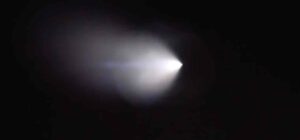
You can watch a video of what this looked like in real time here.
Shortly after, the Pentagon issued a statement that the “Navy Strategic Systems Programs conducted a scheduled test of a Trident II (D5) missile from USS Kentucky, an Ohio class submarine.”
The US Navy claimed the launch was scheduled, as part of its ongoing testing program to ensure accuracy and readiness. The missile was not armed, but the Trident II is capable of being loaded with nuclear warheads and has a range of over 7,000 miles.
This specific launch took place at 6pm Pacific Time, on a Saturday night, over one of the most populated areas in North America – a clear display of US military weaponry. What was the intention of this demonstration?
A couple of weeks prior, over 20,000 pages of sensitive information were declassified and released to the public by the US Government. The details in these documents “describe the U.S. Air Force’s secret cold war project known as the Manned Orbiting Laboratory.”
(I’ll talk more about this in a little bit. You can review all 20,681 pages, which span across 825 documents HERE.)
The Cold War heated up over secret space tech.
The exact dates of the start and end of the Cold War are debated. However, it’s generally accepted that the conflict began right after World War II and ended with the fall of the USSR in 1991.
The secret space war, which is still going on today, got its start in 1957. That’s the year when Russia successfully launched the Sputnik satellite that orbited the earth for three months before falling back into the atmosphere in early 1958.
This achievement by the Russians was not just about the actual Sputnik satellite. That’s because the satellite was propelled into space using intercontinental ballistic missile (ICBM) technology.
Prior to this satellite launch, the US was the undisputed world power. Then, over night, the Russians changed everything in the eyes of Western nations.
The Sputnik crisis spurred a new war of back and forth technological advancements that most of the world never even knew about… even though much of what was happening was right in front of our eyes – in the sky.
In the declassified documents that were made public right before the Trident missile launch in 2015, there are some very interesting things…
For example, the “Manned Orbiting Laboratory” (MOL) was not what it sounds like. Its real purpose was to spy on the Soviet Union using a spy satellite code named “Dorian.”
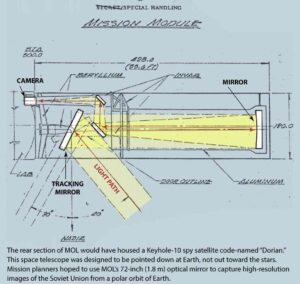
Source: Space.com / Karl Tate
The US spent close to $200 billion in today’s money to develop the MOL, but the project was never actually launched. “According to the National Reconnaissance Office, the program was cancelled because of budgetary pressure from the Apollo program and the Vietnam War. There also was a political perception that MOL duplicated what NASA was doing with its human spaceflight program.” –Space.com
But it wasn’t just spying that the MOL was being designed for… There were also plans to engage in actual combat in space.
Throughout the 1960’s and 1970’s the Soviet Union designed and launched several secret military space stations.
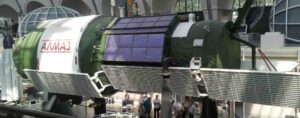
One of several Russian Almaz space stations developed (currently on display) that were armed with cannons. Source: National Interest
At least one of these stations was armed with a cannon, similar to what is installed on a Russian Mig fighter jet.
“However, there was something different about Salyut 3/Almaz 2. It wasn’t just a military space station. It was an armed military space station. Almaz 2 was equipped with a small cannon to test whether Soviet spacecraft could protect themselves from American anti-space weapons.” –N.I.
While there is little to no evidence that the US had (or currently has) its own secret military space station, it’s highly likely that the Russians are not the only ones with secret space war capability.
The new secret space war.
“If the U.S. is to avoid a ‘Space Pearl Harbor,’ it needs to take seriously the possibility of an attack on the U.S. space system.”
That quote is from a 2001 report issued by Donald Rumsfeld, “to assess the organization and management of space activities in support of U.S. national security.” In that same report, there is an entire section about the proposed development of the “Space Corps.”
Nearly 20 years later, in December of 2019, President Donald Trump formed the US Space Force. Logistically, this meant taking all member’s of the US Air Force’s Space Command and reassigning them to the new branch of the military – the first new branch since 1947.

Col. Anthony Mastalir, Space Launch Delta 30 commander, and Maj. Gen. Deanna Burt, Combined Force Space Component Command commander, unveil Vandenberg’s new U.S. Space Force name during a base renaming and 30th Space Wing redesignation ceremony May 14, Vandenberg Space Force Base, Calif. (Source: U.S. Space Force photo by Michael Peterson)
Trump was profusely mocked for this, with the media running with multiple different jokes. MSNBC infamously questioned if Biden would shut the US Space Force down…
“Will the incoming administration put an end to this unnecessary exercise that Trump admits started as an offhand joke?” –MSNBC
Of course, we now know that the exact opposite happened. As I mentioned a couple weeks ago…
“Instead of shutting down the Space Force, Biden is actually increasing its funding. President Biden’s 2023 defense budget request has allocated more than $24 billion to the Space Force. That’s almost a 40% increase in spending proposals compared to 2022.”
And that’s not the only surprise that the US Government has for the secret space war…
The secret space war weapon yet to be unveiled.
Special Access Programs (SAPs) are considered to be the highest level of security protocols for the US Government. Usually, highly sensitive information is contained within these levels of communication, which is limited a very small and often compartmentalized group of individuals.
The use of SAPs can range from US Presidential transportation support all the way to sensitive nuclear weapon information. Often times sensitive military projects are contained within SAPs to ensure successful development before being shared with the world.
A secret space weapon, which has been safeguarded within a SAP, has been waiting to be announced for a couple of years…
“The Trump administration considered revealing the space weapon as early as the annual Space Symposium conference in 2020, a prestigious event for the national defense community. The idea was to showcase the technology as a validation of the Space Force and Space Command, which is responsible for military operations in outer space. However, the conference was canceled due to the COVID-19 pandemic.” –ARS Technica
Plans to unveil this new weapon were postponed until 2021… and then the fall of Afghanistan cancelled those plans. Now, with the ever-escalating conflict in Ukraine, perhaps we’ll never see this new weapon… that is, until it’s used in a real world situation.
So what is this new top secret space weapon that the US military wants to show the world? Well, we’re not sure yet. According to an exclusive report by Breaking Defense:
“The system in question long has been cloaked in the blackest of black secrecy veils — developed as a so-called Special Access Program known only to a very few, very senior US government leaders. While exactly what capability could be unveiled is unclear, insiders say the reveal is likely to include a real-world demonstration of an active defense capability to degrade or destroy a target satellite and/or spacecraft.”
This report, which was published in August of 2021, was during a completely different view of the world… at least from a US perspective.
How plans can change, at hypersonic speed.
A month prior to the publication of the Breaking Defense report, China tested a missile that the world had never seen. Although it took several months for the US to confirm the launch (which China denied), the details were sobering.
“China has tested a nuclear-capable hypersonic glide vehicle, carried on a rocket, that flew through low-orbit space and circled the globe before striking within two dozen miles of its target, U.S. intelligence sources told the Financial Times.”
Then, as I wrote about in early April, “Russia has claimed to have used the first hypersonic missile in combat, which the US has confirmed, in Ukraine.”
There is a clear and obvious arms race underway between the world’s superpowers. Is that what has delayed the announcement of the US top secret space war weapon?
“Some experts suggest that the impetus for Beijing’s possible development of this system can be tied partly to its concerns about U.S. missile defenses. “This is almost certainly, on a technical and strategic level at least, motivated by concerns about a potential breakthrough in U.S. missile defense capabilities,” tweeted Ankit Panda, the Stanton Senior Fellow at the Carnegie Endowment for International Peace, on Oct. 18.” –Arms Control
Then, early this month, the US had it’s own announcement:
“DARPA and its U.S. Air Force partner recently completed a free flight test of the Lockheed Martin version of the Hypersonic Air-breathing Weapon Concept (HAWC). The vehicle, after release from a carrier aircraft, was boosted to its Aerojet Rocketdyne scramjet engine ignition envelope. From there, it quickly accelerated to and maintained cruise faster than Mach 5 (five times the speed of sound) for an extended period of time. The vehicle reached altitudes greater than 65,000 feet and flew for more than 300 nautical miles.”
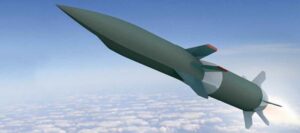
Artist rendering of the US hypersonic weapon. Source: DARPA
The first successful test for the US was in September of last year, which was literally within months of both China and Russia all successfully showing off their own technologies. With confirmation of all three world superpowers having similar technologies, what will be the next strategic move?
China recently announced that “they have built and tested an anti-satellite robotic device that can place a small pack of explosives into a probe’s exhaust nozzle. Rather than blowing the satellite into pieces, the melt-cast explosive can produce a “time-controlled, steady explosion.”
Meanwhile, Russia has committed to returning to the moon. The WSJ recently reported, “Mr. Putin said Russia would continue work to develop a new-generation transport vehicle as well as nuclear space-energy technologies, where Russia has a “clear advantage,” but didn’t elaborate. He also said Russia would significantly expand its constellation of satellites.”
And we’re still waiting to see what secret space war weapon the US will unveil.
(On April 18th, the Biden administration announced a ‘self-imposed ban’ of anti-satellite (ASAT) weapons. Specifically, weapons that blow up satellites, potentially creating debris problems in space. Russia recently executed one of these tests in November of 2021. However, as mentioned by Payload, “The ban doesn’t extend to other types of ASAT testing. Countries have other kinetic and non-kinetic ASAT weapons at their disposal.”)
How the secret space war impacts our lives.
There are currently thousands of satellites that orbit our earth which play an integral role in our everyday lives. In fact, it’s difficult to explain how important these technologies are.
According to the United Nations Office of Outer Space Affairs, there are currently over 12,500 objects that have been launched into outer space. Many of those objects are communication satellites that make our global economies and societies operate smoothly. (You can search the database of objects launched into space HERE.)
When it comes to satellites, most people think about television, radio, or GPS. But that’s just scratching the surface. Satellite technology is responsible for everything from weather forecasting and environmental monitoring, to credit card transactions and video conferencing.
In Q4 of 2021, an incredible 326 spacecraft (mostly satellites) were launched. That means we will have thousands of more spacecraft orbiting the earth within the next couple of years.
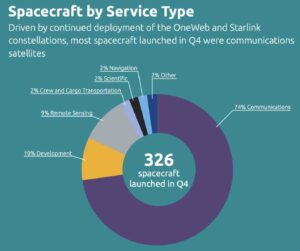
Source: Bryce Tech Reports
The overwhelming majority of these launches were focused on getting new technologies into space to support our earth based communications systems. As shown by the graphic above, OneWeb and Starlink were responsible for most of these new spacecraft.
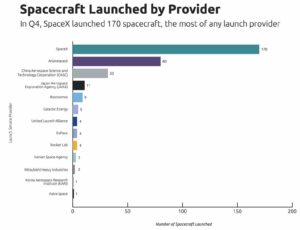
Source: Bryce Tech Reports
Starlink has recently had massive success with its deployment of land based hardware throughout Ukraine. Meanwhile, small companies are also getting creative with Starlink, enabling people to connect to the internet in the most remote of places.
Whether satellites help with wartime operations, recreational activities, or simple entertainment… You can start to see how dependent our entire society is on high tech space equipment. This makes all of us, wherever we’re located on the globe, very vulnerable to any nefarious attacks on satellites or other spacecraft.
Space investing isn’t just about moon-shots anymore.
Unlike the space race of the early Cold War era, getting to the moon isn’t at the top of the list. Instead, space infrastructure, public space travel, and general space related technology is where investors are putting their money.
2021 saw a flurry of private deals funded, with the total investment amount almost doubling from the prior year. Compared to just a decade ago, space startup funding is exponentially higher.
 Source: Bryce Tech Reports
Source: Bryce Tech Reports
Compared to 2020, the start-up space ecosystem in 2021 was transformational:
- Start-up space deals were up 48% from 2020 (241 deals in total)
- Unique companies receiving investment were up 46% (212 in total)
- Average deal size was up by 35% ($64 million average)
And start-ups are doing much more than just getting funded. 2021 was also a record year for start-up space acquisitions.
 Source: Bryce Tech Reports
Source: Bryce Tech Reports
Some of these acquisitions were by private companies, such as Swarm Technologies being bought by SpaceX in a deal that was likely over $100 million. Other acquisitions were through SPAC transactions, where private companies went on to become publicly traded.
The public space market absolutely exploded in 2021:
 Source: Bryce Tech Reports
Source: Bryce Tech Reports
Unfortunately, many of those SPACs haven’t performed too well in public markets. Currently, almost all space SPACs launched in 2021 trade below their IPO price. Are there buying opportunities? Or were they overvalued to begin with?
 Source: Bryce Tech Reports
Source: Bryce Tech Reports
If you’re not looking to pick individual stocks, you can instead invest in an ETF. There are many available options:
- $ROKT – SPDR S&P Kensho Final Frontiers ETF – 0.45% management fee
- $UFO – Procure Space ETF – 0.75% management fee
- $ARKX – ARK Space Exploration & Innovation ETF – 0.75% management fee
- $ITA – iShares U.S. Aerospace & Defense ETF – 0.42% management fee
- $XAR – SPDR S&P Aerospace & Defense ETF – 0.35%
- $DFEN – Direxion Daily Aerospace and Defense Bull 3X shares – 0.96% fee
As shown by the recent performance of most public space companies, investors may want to look at the private markets. Specifically, the US is where private space companies are booming.
US space entrepreneurs and investors are leading the world.
The United States has been the birthplace for some of the worlds most transformational companies. When it comes to space, the trend continues…
 Source: SpaceTech Analytics
Source: SpaceTech Analytics
As many investors know, private companies are off limits to those who are not accredited. Some of the best space companies in the world that are still private, like SpaceX, have only raised capital from those who are of a certain net worth.
However, with the introduction of new crowdfunding investment options, there are new avenues for space investors to pursue. Specifically, Spaced Ventures now allows non-accredited investors to invest in private space companies.
Regardless of the way you invest, the industry as a whole is projected to grow significantly. Morgan Stanley predicts that the, “industry could generate revenue of more than $1 trillion or more in 2040, up from $350 billion, currently.”
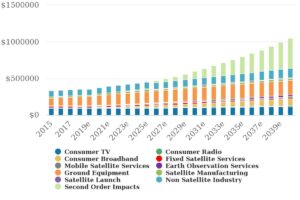 Source: Morgan Stanley
Source: Morgan Stanley
Where will the secret space war lead us?
In 2018, Politico published an article about how unprepared the United States is to fight a war in space.
“Russia and China are years ahead of the United States in developing the means to destroy or disable satellites that the U.S. military depends on for everything from gathering intelligence to guiding precision bombs, missiles and drones.
Now the Pentagon is trying to catch up — pouring billions more dollars into hardening its defenses against anti-satellite weapons, training troops to operate in the event their space lifeline is cut, and honing ways to retaliate against a new form of combat that experts warn could affect millions of people, cause untold collateral damage and spread to battlefields on Earth.”
While I don’t look forward to the prospect of any type of war, I personally do think it’s highly likely there will be some kind of conflict in space before 2030.
In the meantime…
Let’s hope that brilliant risk-taking entrepreneurs, who are backed by adventurous risk-taking investors, can solve some of the world’s biggest problems.




